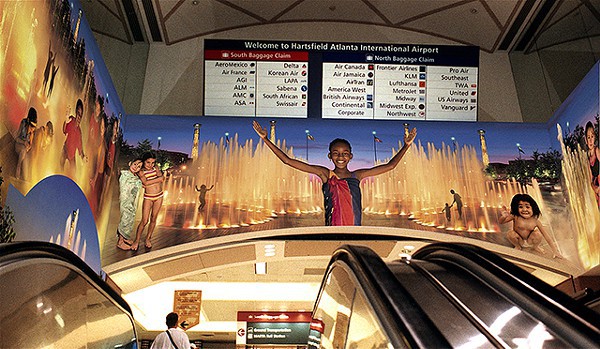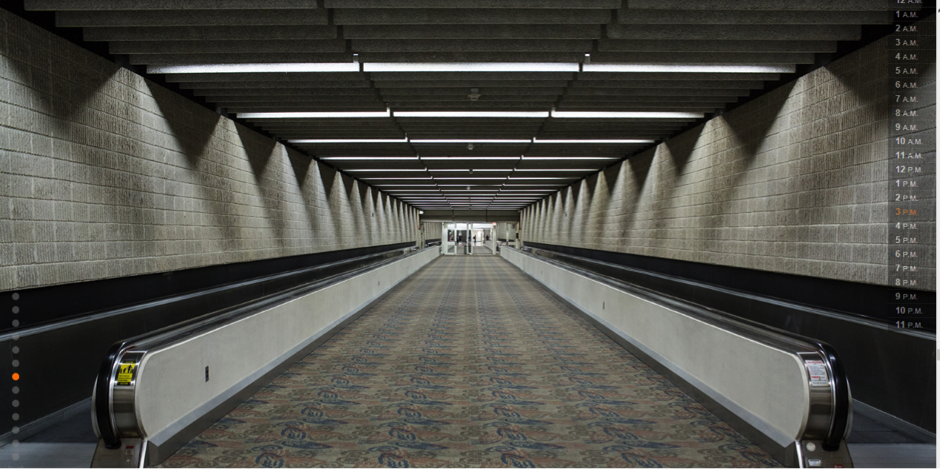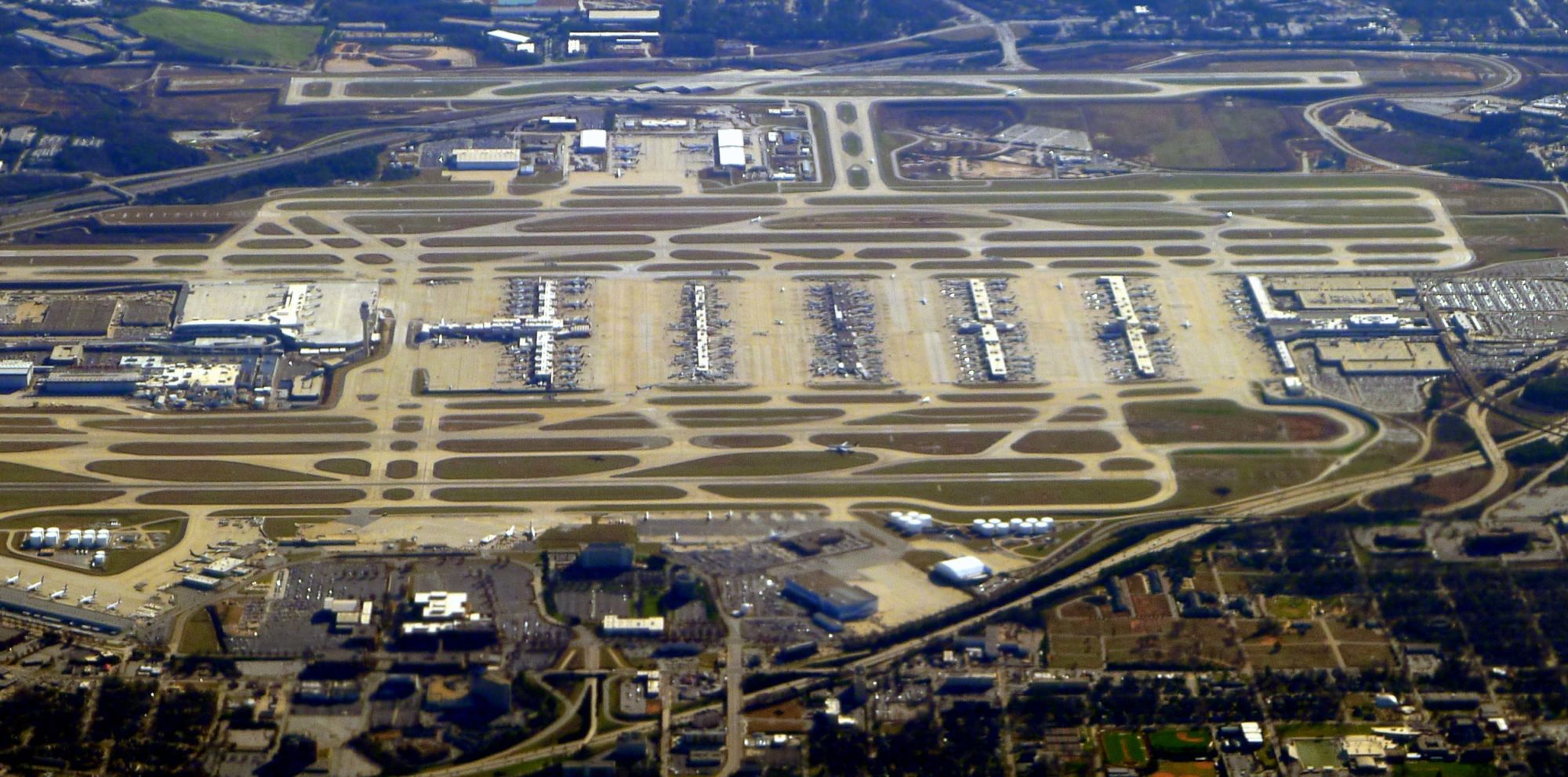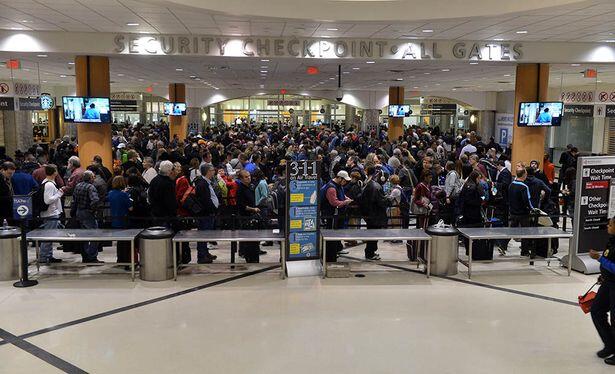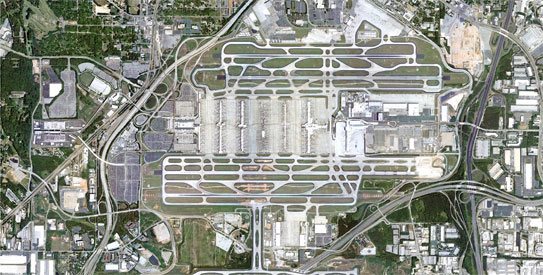The Possibility of an Airport
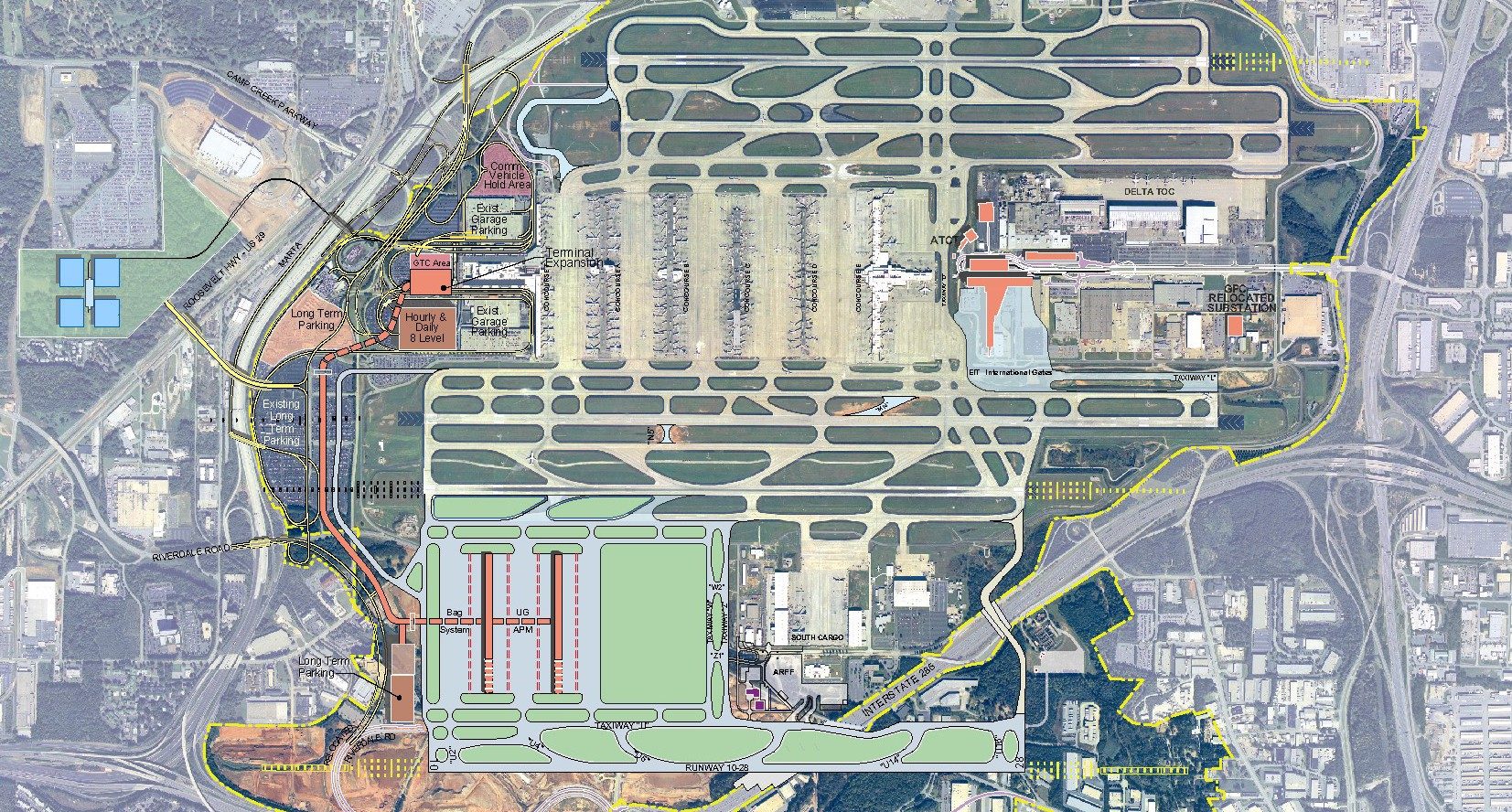
Aerial Plan.jpg, Google Earth screen grab
Hartsfield-Jackson Atlanta International Airport, more commonly known by its IATA code as ATL, is the "largest" airport in the world in terms of passenger traffic. It is about to get larger: from 96 million passengers today to roughly 130 million in 2030.((As part of the development process, in June of 2015 the City of Atlanta and the Department of Aviation issued an RFP for the "Modernization of the Landside of the Central Passenger Terminal." The RFP provides for a growth of the airport from 96 million passengers (PAX) to roughly 130 million PAX. Although there appears to be consensus on the potential of Atlanta Airport to achieve major improvements, the RFP calls for largely cosmetic interventions: new awnings over the passenger arrival zones, refurbished retail kiosks, and improved baggage conveyor belts.)) When it reaches that number, it will no longer be the largest. By then, an even larger airport will have opened: Al Maktoum International Airport in Dubai, expected to process 160 million passengers annually.
Share:
Size matters. Atlanta’s airport was largely responsible for the acquisition of the Olympics in 1996; city officials argued that it was one of the only bidding cities that could handle the arrival and departure of the expected numbers of visitors. The acquisition of the Olympics fueled further development of the airport, with new amenities and the opening of a dedicated international terminal in May 2012.1 In 2015, Hartsfield-Jackson Atlanta International Airport was ranked the world’s busiest airport for the 17th consecutive year.
In a world with little consensus otherwise, size equals competence. It becomes a measure of success, a paradigmatic feature that inspires emulation. Atlanta Airport’s appeal is rooted in no other fact than that it is the largest. As the aftermath of the Olympics has demonstrated, being the largest allows one to stay the largest—at least for a very long time. Nothing breeds success like success.
If modernity was an idea initially predicated on the search for form to express progress, it is now a rat race—subject to the inescapable imperative of the market economy: competition. In that context only the measurable survives. The ultimate outcome of modernization isn’t the triumph of an ideal form but instead its ultimate irrelevance in the face of numbers. Form defers to performance. Atlanta Airport is no exception.
I remember the first time I set eyes on Atlanta Airport. It was on paper. I encountered it in the capacity in which most people in my profession do: as a benchmark, a compelling 90-degree-only rhythm of five parallel independent concourses, connected by a People Transport System (PTS) running in a tunnel underneath. A pair of terminals stood at each end—one domestic, one international. The whole complex was flanked by parallel runways— a pair on either side. The almost unfeasibly simple composition offered a seductive paradigm. (Al Maktoum, the airport that will overtake Atlanta as the busiest airport in the world, is an exact copy.)
Courtesy Hartsfield Jackson International Airport
Atlanta Airport is a masterpiece, a sublimely utilitarian creation unburdened by sentimentality. It is ostensibly a product of the machine age. Literally. Mechanical transport takes priority. What the elevator was to the skyscraper, the PTS is to the airport. In the same way that the elevator opened up the possibility for the disjunction between the floors of a building in section, the PTS opens up the possibility of a disjunction in plan. The airport becomes a collage of disjointed fragments. If the skyscraper is a reproduction of the world in the vertical, Atlanta Airport is that in the horizontal.
Atlanta Airport has history. There were earlier configurations, but nobody remembers them (originally it was a racetrack). Not only has each new layer erased all previous ones, it has also erased any memory of them. Atlanta Airport is the outcome of successive amnesias. Still, pinned up on the wall during a student review, a sequence of the airport’s past incarnations (the result of an intensive archive search) strangely manages to feel like an evolution: not a gradual growth toward its present state, but rather a journey toward the ideal diagram. An evolution in the thinking about airports, more than an evolution of their physical reality.
Prior to my ever visiting the airport, I had proposed its diagram in the context of multiple other airport projects, either for new airports, or for airports facing vast expansions. When I finally did visit—like most people, during a layover on my way to another continent—the experience was predominantly one of disbelief. It isn’t so much that when you get there, there is no there; rather, the “there” you find there is a completely different there than the one implied by (the perfection of) the diagram. Order from the sky leads to chaos on the ground, functionality on paper creates impasse in reality, perfection in two dimensions produces its breakdown in the third. In many ways, the Atlanta airport is a case of the ideal diagram causing the perfect nightmare. This is the shared secret of all those who have used ATL (more than a billion by now).
The Atlanta airport is an homage to the central perspective, a strange case of les extremes se touchent, where radical modernity equals perfect classical order. It is also the perfect setting for a Kubrick movie…
This contrast between the seemingly ideal diagram and its flawed reality raises an obvious question: are diagrams important? Or are they just an illusory shield to protect architects from the chaos that inevitably ensues, with or without them? In forever avoiding a finite state, the airport defies the diagram’s main implication. It is formless by definition, exemplifying above all the impossibility of any definitive configuration.
Like most airports, Atlanta’s is in a constant state of conversion. Ever larger billboards with ever more renderings of an ever more promising future conceal the current surroundings in exchange for a better one tomorrow … next week … next month … next year. Prolonged expectation—or suspended disbelief—followed by disappointment is the quintessential experience of an airport, like waiting for a flight that is eventually cancelled.
There is some official recognition of the airport’s shortcomings in the Navigate 2030: ATL Masterplan (2014), which will dictate the development of Atlanta Airport through 2030. The ATL Masterplan was assembled over two years, through phases titled Inventory, Capacity Assessment, Proposal of Alternatives, and an Implementation Plan. At this point, the study has already announced a need for new gates, a doubling of parking capacity, and the introduction of a sixth runway.2 To achieve this, the airport plans to spend about $779 million on construction in 2017. (Other airports typically spend between $25 and $75 million annually.3) Even with this commitment, it remains a question if any of these measures will really change anything—that is, whether it is really the airport that should change, or our perception of it. For decades, we have viewed airports as purely logistical entities, as machines. More recently, however, it is becoming increasingly clear that what we thought to be the airport’s main raison d’etre is in fact no more than a pretext.
“It’s insane. I’ve never been in a bigger or busier airport and I only saw two terminals.”
—Flickr user MFMinnMFMinn, The busiest airport in the world, January 2, 2012 [via Flickr]
The planning of airports has changed significantly over the last 20 years. Airports have become subject to intensified international competition. They need to offer favorable conditions to airlines, particularly their home carriers—Delta, in the case of ATL—and to stay in business, landing rights and tariffs have to remain within limits. As a result, airports are increasingly dependent on revenues from alternative, non-aviation related sources. Airports must acquire multiple identities—as shopping centers, hotel operators, real estate ventures. A paradigm shift ensues: instead of airports remaining a peripheral inconvenience to the city, cities start to develop around airports. City airports become Airport Cities.4
Currently, 85% of all passengers flying in and out of Atlanta Airport are transfer passengers. With the current growth plans, these numbers are likely only to increase. This large number of transfer passengers makes Atlanta Airport virtually an autonomous entity, independent from the city of Atlanta itself. Most passengers never actually get to see Atlanta. With only 15 million passengers per year destined for Atlanta itself, ATL, in terms of local traffic, is smaller than Zurich’s airport. The city of Atlanta is not so much the raison d’etre for the airport as much as its facilitator, a service provider, mostly as a reservoir of cheap labor. It is the airport that has the upper hand, a city in its own right, which for the vast majority of travelers has replaced Atlanta.
The airport’s official name is Hartsfield-Jackson Atlanta International Airport. It used to be just Hartsfield, named after a former Atlanta mayor, but then the widow of his successor, Maynard Jackson, successfully petitioned to add the latter’s name. (She is even rumored to have appeared in court to pursue a greater emphasis on it, too.) Picture its name were the city’s current mayor, Kasim Reed, to add himself to the list: Hartsfield-Jackson-Reed Atlanta International Airport. Somehow, the more successive city officials who are attached to it, the more the airport’s independent brand seems reinforced: ATL.
AJC, Long waits greet fliers as they return to Hartsfield-Jackson, February 13, 2014 [via Twitter]
Perhaps the relation between the Atlanta Airport and the City of Atlanta is conceptual rather than territorial. In the Office for Metropolitan Architecture’s famous tome, S,M,L,XL(1995), there is an essay about Atlanta as the next state of modernity: the explosion of the center into a ubiquitous periphery.5 In the last instance a ubiquitous periphery also destroys the notion of the periphery itself: without center, no periphery. The city becomes atomized. This atomization, described as an essential feature of Atlanta at the scale of the city, is reproduced by its airport at a global level: as an accumulated stopover in journeys from elsewhere to elsewhere, the airport is “nowhere,” by definition. Its population belongs everywhere but there. The airport offers a sneak preview of a future without loyalty to place. We better learn to like it, cherish it as ours, if only for a few hours.
Architecture or urbanism? That is the question. In architectural terms, the airport represents the successive breakdown of stated intentions. In an urbanistic sense it represents the opposite: the unleashing of potential. Where architecture insists on a form of behavioral innocence implied by the purity of its organigrams (it expects them to be followed), urbanism exists only in the knowledge that its blueprints will be ignored. Its true genius resides in recognizing that its diagrams in no way control what happens afterward.
Aerial Plan.jpg, Google Earth screen grab
It is in this urbanistic notion that the relevance of Atlanta Airport’s diagram lies: not as the end, but as the beginning of something, in accelerating a scenario that otherwise would only happen over centuries. The diagram doesn’t prevent complexity; it makes the complexity instant, bypassing an excruciating process of evolution. An operation the size of an airport has no time to wait for evolution; evolution is what happens afterward, through an endless process of conversions, corrections, etc., in the form of a search for a perfection that will never come. In an airport, evolution is a retroactive concept: it happens not before, but after—in the gradual destruction of its own perfection.
The primary function of an airport is to serve movement. Therein lies its true modernity: not progress but progression, even if we have no idea what we progress toward. Baudrillard once described the American highways as places of conformism: “a route that leads nowhere, but keeps one in touch with everyone. Any speculation about the future is pointless …. The whole point is to keep thinking about the future, if only as an existential ritual …. It is important to suspend any definitive conclusions … we’re all going somewhere, even if it doesn’t matter where.” The airport is an even more radical embodiment of this metaphor: a place one goes to only to leave.
When planes land, they cost money; they are meant to be up in the air, preferably permanently. In that sense, an airport is no more than a necessary evil, the last obstacle in the way of constant movement (and constant revenue), an admission of failure in our eternal effort to create the perpetuum mobile, a final station on the route to real modernity: ultimately, a disappearing act.
Reinier de Graaf is a partner in the Office for Metropolitan Architecture (OMA), where he is responsible for building and master-planning projects in Europe, Russia, and the Middle East. De Graaf heads the work of AMO, OMA’s think tank, in which capacity he frequently lectures and publishes on the state of the architecture profession. He is a visiting professor at University of Pennsylvania, teaching a studio about the future of Atlanta Airport (ATL). De Graaf is currently working on a book titled Megalopoli(tic)s.
References
| ↑1 | International Olympic Committee, “FACTSHEET: Legacies of the Games,” updated, December 2013. |
|---|---|
| ↑2 | Dave Williams, “New Atlanta airport Master Plan eyes new gates, sixth runway,” Atlanta Business Chronicle, August 27, 2014. |
| ↑3 | Kelly Yamanouchi, “Airport plans nearly $800M of work in 2017,” Atlanta Journal-Constitution, December 5, 2014. |
| ↑4 | J.F., “The Economist explains: What is an aerotropolis?” The Economist Online, December 11, 2013. |
| ↑5 | S,M,L,XL, Rem Koolhaas, “Atlanta – Journalism, 1987 / 1994,” Rem Koolhaas, Bruce Mau, OMA, S, M, L, XL (New York: The Monacelli Press, 1995), pp. 832Ğ860. |
